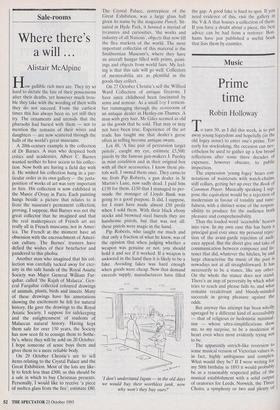Sale-rooms
Where there's a will ...
Alistair McAlpine
H ow gullible rich men are. They try so hard to dictate the fate of their possessions after their deaths, yet however much trou- ble they take with the wording of their wills they do not succeed. From the earliest times this has always been so. yet still they try. The ornaments and utensils that the pharaohs had buried with them — not to mention the remains of their wives and daughters — arc now scattered through the halls of the world's great museums.
A 20th-century example is the collection of Dr Barnes. A man who despised both critics and academics, Albert C. Barnes wanted neither to have access to his collec- tion. Now both are having a field day with it. He wished his collection hung in a par- ticular order in its own gallery -- the juxta- position of works of art was very important to him. His collection is now exhibited in the Musee d'Orsay in Paris. Each painting hangs beside a picture that relates to it from the museum's permanent collection, proving, I suppose, that Barnes was not the great collector that he imagined and that the real masterpieces of French art are really all in French museums, not in Amer- ica. The French at the moment have an obsession with the encroachment of Ameri- can culture. The Barnes' trustees have defied the wishes of their benefactor and pandered to this phobia.
Another man who imagined that his col- lection was carefully tucked away for eter- nity in the safe hands of the Royal Asiatic Society was Major General William Far- quhar, called 'the Rajah of Malacca'. Gen- eral Farquhar collected coloured drawings of animals, plants, birds and insects. Many of these drawings have his annotations showing the excitement he felt for natural history. He gave the drawings to the Royal Asiatic Society, I suppose for safekeeping and the enlightenment of students of Malaccan natural history. Having kept them safe for over 150 years, the Society has now seen fit to consign them to Sothe- by's, where they will be sold on 20 October.
I hope someone of sense buys them and gives them to a more reliable body.
On 29 October Christie's are to sell items relating to the Crystal Palace and the Great Exhibition. Most of the lots are like- ly to fetch less than £500, so this should be a sale in which to buy Christmas presents. Personally, I would like to receive 'a piece of molten glass from the fire', estimate £80.
The Crystal Palace, centrepiece of the Great Exhibition, was a large glass hall given its name by the magazine Punch. Sit- uated in Hyde Park, it housed a myriad of treasures and curiosities, 'the works and industry of all Nations', objects that now fill the flea markets of the world. The most important collection of this material is the Smithsonian Museum's, where they have an aircraft hangar filled with prints, paint- ings and objects from world fairs. My feel- ing is that this sale will go well. Collectors of memorabilia are as plentiful as the goods they collect.
On 27 October Christie's sell the Wilfred Ward Collection of antique firearms. I have since childhood been fascinated by arms and armour. As a small boy I remem- ber rummaging through the storeroom of an antique dealer in Henley-on-Thames. A man with grey hair. Mr Giles seemed as old as the goods that he sold. That may or may not have been true. Experience of the art trade has taught me that dealer's geese often in telling become antique swans.
Lot 48, 'A fine pair of percussion target pistols', caught my eye, estimate £5,500: pistols by the famous gun-makers J. Purdey in mint condition and in their original box with all their accessories. I know these pis- tols well. I owned them once. They came.to me from Pip Roberts, a gun dealer in St Martin's Lane, now sadly dead. I paid him £150 for them, £150 that I managed to per- suade the manager of Lloyds Bank was going to a good purpose. It did, I suppose, for I must have made almost £50 profit when I sold them. With their black ebony stocks and browned steel barrels they are handsome pistols, but that was not all: these pistols were magic in the hand.
Pip Roberts, who taught me much and that only a fraction of what he knew, was of the opinion that when judging whether a weapon was genuine or not, you should hold it and see if it worked. If a weapon is awkward in the hand then it is likely to be a fake. Avoiding fakes was hard enough when goods were cheap. Now that demand exceeds supply, manufacturers have filled don't understand Japan — in the old days we would buy their worthless junk, now why won't they buy ours?' the gap. A good fake is hard to spot. If you need evidence of this, visit the gallery ill the V & A that houses a collection of them. If you have a doubt about a piece, the best advice can be had from a restorer: Bon- hams have just published a useful book that lists them by counties.


































































 Previous page
Previous page